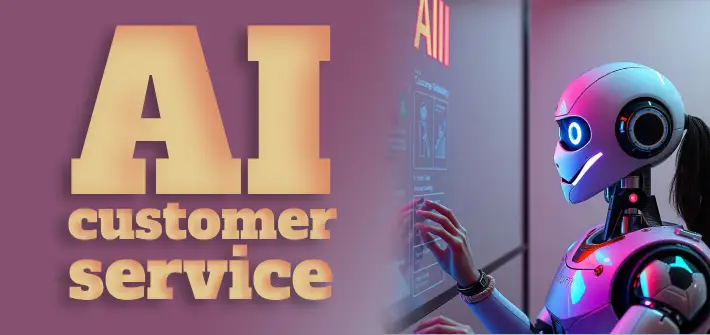In today’s fast-paced digital world, businesses across all industries are increasingly leveraging technology to provide better, faster, and more personalized customer experiences. Among these innovations, AI in customer service has undoubtedly emerged as a game-changer. For instance, it automates responses and analyzes customer preferences, allowing companies to interact with their customers more effectively. Moreover, artificial intelligence is reshaping the way businesses approach customer engagement by streamlining processes and delivering tailored solutions. In this comprehensive article, we will not only explore how AI is transforming customer service but also discuss its benefits, real-world examples, potential drawbacks, and promising future.
Table of Contents
The Role of AI in Customer Service
Artificial intelligence is at the heart of the modern customer experience. Not only does it enable businesses to offer personalized interactions, but it also streamlines processes and resolves customer issues efficiently. Moreover, companies leverage AI for customer insights, predictive analytics, and automation, which collectively lead to higher satisfaction and loyalty. As a result, industries are increasingly embracing AI-powered tools like chatbots and virtual agents. Consequently, the era of proactive and intelligent customer service is truly here.
Key Functions of AI in Customer Service
- Automation of Repetitive Tasks: AI can handle basic inquiries, freeing up human agents for more complex tasks.
- Personalized AI Experiences: Machine learning algorithms analyze customer data to offer tailored solutions.
- 24/7 Availability: AI-powered systems, such as chatbots, provide round-the-clock assistance, improving accessibility.
What is AI in Customer Service?
AI in customer service refers to the use of artificial intelligence technologies to automate, personalize, and enhance customer interactions. For instance, AI systems can process vast amounts of data, predict customer behavior, and deliver tailored solutions. As a result, businesses can ensure improved customer satisfaction. Moreover, with tools like chatbot technology and AI customer service agents, companies can respond to queries instantly and efficiently handle repetitive tasks.
Examples of AI in Customer Service
- Chatbots and Virtual Assistants: Companies like Amazon and Apple use chatbot technology to provide real-time assistance to customers. For instance, Apple’s Siri or Amazon’s Alexa handles customer inquiries efficiently.
- Personalized AI Experiences: Netflix and Spotify leverage AI to offer tailored recommendations based on user preferences, elevating the customer experience.
- AI for Customer Insights: Retailers use AI-powered analytics tools to gain insights into customer behavior, helping them make informed decisions about product offerings and marketing strategies.

Benefits of AI in Customer Service
1. Enhanced Customer Engagement
AI-powered tools enable businesses to deliver personalized AI experiences. For instance, by analyzing customer data, AI can suggest products or services that closely align with individual preferences. As a result, this level of personalization not only enhances customer satisfaction but also fosters deeper loyalty.
2. 24/7 Availability
AI customer service agents provide round-the-clock support. Unlike human agents, chatbots and virtual assistants can handle multiple inquiries simultaneously, reducing response times and ensuring continuous service.
3. Cost Efficiency
Automating routine tasks with AI reduces operational costs. Businesses save money by minimizing the need for large customer support teams while maintaining high service levels.
4. Improved Decision-Making
Using AI for customer insights, businesses can make data-driven decisions. AI analyzes customer feedback, reviews, and purchasing behavior to predict trends and optimize offerings.
Disadvantages of AI in Customer Service
Despite its advantages, AI in customer service also comes with challenges.
1. Lack of Human Touch
While chatbot technology is efficient, it can sometimes feel impersonal. Customers with complex issues often prefer interacting with a human who can empathize and provide nuanced solutions.
2. Miscommunication Risks
AI systems may misinterpret queries due to language barriers or ambiguous phrasing, leading to frustration among customers.
3. High Implementation Costs
Developing and integrating AI systems into customer service operations can be expensive, especially for small and medium-sized enterprises (SMEs).
4. Data Privacy Concerns
Using AI requires collecting and processing vast amounts of customer data. Companies must ensure compliance with data protection laws to avoid breaches and maintain trust.
Chatbot Technology: A Core Component of AI in Customer Service
Chatbots have become a cornerstone of AI-powered customer service. These virtual agents can handle a wide range of tasks, from answering FAQs to processing transactions.

Advantages of Chatbots in Customer Service:
- Immediate responses to customer inquiries
- Cost-effective support solutions
- Consistency in communication
Challenges of Chatbots:
Despite their efficiency, chatbots may fail to understand complex queries or provide human-like interactions.
How Industries Use AI to Transform Customer Experiences
Retail
Retailers use AI not only for personalized recommendations but also for inventory management and dynamic pricing. For instance, AI tools analyze purchasing history and browsing behavior, which allows them to suggest products that closely match customer preferences. Moreover, these insights help businesses optimize their operations and enhance the shopping experience.
Healthcare
In healthcare, AI streamlines appointment scheduling, offers virtual consultations, and answers patient inquiries through chatbots. It ensures timely responses, enhancing the patient experience.
Banking and Finance
Banks deploy AI customer service agents to assist customers with account inquiries, transaction details, and fraud detection. AI also enhances personalization in financial planning services.
Travel and Hospitality
Airlines and hotels rely on chatbot technology not only for booking inquiries but also for itinerary management and customer feedback collection. Moreover, AI ensures seamless travel experiences by effectively handling disruptions when they occur.
Future of AI in Customer Service
The future of AI in customer service promises even more transformative changes.
- Hyper-Personalization
AI will evolve to understand customer preferences at an individual level, delivering hyper-personalized experiences. Machine learning models will analyze even the smallest customer data points to create bespoke interactions. - Voice and Emotion Recognition
Future AI systems will recognize customer emotions and adjust responses accordingly. This will add a human-like dimension to interactions, bridging the gap between automation and empathy. - AI-Powered Predictive Analytics
AI will predict customer needs before they arise, enabling proactive problem-solving. For example, airlines could use predictive analytics to inform passengers of potential delays and provide alternative solutions in real time. - Integrated Multichannel Support
AI will unify customer interactions across various channels—social media, email, and live chat—ensuring seamless communication. Customers will receive consistent and personalized service regardless of the platform. - Advanced AI Chatbots
AI in customer service and chatbots will move beyond simple queries to handling complex issues. These chatbots will learn from past interactions, providing smarter and more context-aware responses.
How to Implement AI in Customer Service
Step 1: Identify Key Areas for Automation
Start by pinpointing repetitive tasks like answering FAQs or managing appointment scheduling. These are ideal for automation using chatbot technology.
Step 2: Choose the Right Tools
Select AI tools that align with your business needs. For example, use AI platforms with robust data analysis capabilities if you aim to enhance customer insights.
Step 3: Train Your AI Models
Ensure your AI systems are trained on relevant data. Training helps improve accuracy and makes AI systems more effective in delivering tailored solutions.
Step 4: Monitor and Improve
Continuously monitor AI performance to identify areas for improvement. Regular updates and retraining ensure your AI remains effective as customer expectations evolve.
Conclusion
AI in customer service is dramatically transforming the way businesses interact with their customers. By enhancing efficiency and delivering personalized experiences, this technology provides unmatched opportunities for growth and customer satisfaction. However, to fully maximize its potential, businesses must address challenges such as emotional intelligence and privacy concerns.
Looking ahead, the future of AI in customer service appears exceptionally bright. With innovations continually emerging, even better tools are on the horizon to enhance customer experiences further. Consequently, businesses that embrace these advancements will not only remain competitive but also build stronger and more meaningful connections with their customers.



